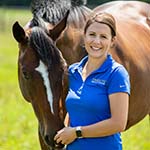Muscle makes up anywhere from 40 to 55% of the adult horse’s body and is impacted by many factors, including age, level of physical activity, nutrition, as well as underlying disease or illness. One of the most common topics around the horse’s muscling is building topline and while this is very important, it is only a snapshot of the role of muscles in the body. There are hundreds of individual muscles in the horse’s body, and each carry out specific jobs. Skeletal muscles are responsible for movement and posture, while smooth muscle helps involuntary processes, like moving food through the digestive tract, and keeping the heart pumping.
Skeletal muscle is the type of muscle that we are looking at when we visually evaluate the horse’s muscling and the type of muscle we aim to condition to support performance. Although topline muscles are just a few of the horse’s many muscles, it is a good area to visualize the horse’s muscling and an area we specifically evaluate as part of the Tribute® Wellness System.
How Do Horse’s Build Muscle?
Muscle is a very active tissue; it is constantly being broken down and remade. Skeletal muscle is made up of long fibers that stretch and contract to create movement. With movement comes small micro trauma, which stimulates muscle synthesis to create repairs. When the rate of muscle synthesis is greater than the rate of muscle breakdown, the muscles will increase in size (hypertrophy). Exercise will stimulate this process.
For muscle to grow, there must be adequate nutrients to support the repair process. The composition of muscle is about 75% water, 20% protein and the remaining 5% is a balance of fat, minerals, vitamins and a small amount of carbohydrate storage in the form of glycogen.
The first nutrient most people focus on to support the muscle is protein. This is broadly correct, but not just any protein will support muscle growth. Most horses get plenty of protein in their diet from forage alone, but we don’t see muscle growth on forage-only diets. There are specific amino acids, the building blocks of protein, that are required to be added to the horse’s diet to allow them to use the protein in their forage. In the horse, lysine is the first limiting amino acid and methionine and threonine are likely limiting, as well.
There is limited research on the impact of Branched Chain Amino Acids (BCAA) on muscle growth in horses. There is a strong focus on BCAA in human nutrition, but the research in horses has been equivocal. It is likely the case that BCAA are often present in great enough quantity in the base diet for many horses. Looking first at the quality of protein in the base diet and whether the limiting amino acids are being added should be the main focus because adding BCAA without enough lysine, methionine and threonine will be ineffective. A BCAA can be added on top of a well-fortified diet without causing any harm and may have the potential to help.
Can Horses Build Muscle with Nutrition Alone?
Yes, horses can build muscle with nutrition alone up to a point. Essentially, horses will build muscle up to their genetic potential when the diet supplies the amino acids and energy needed. This is why we can visually see a difference in the topline of a horse who is retired or otherwise not in work when the diet is adjusted to meet the horse’s needs.
How Can I Help My Horse Build Muscle?
Nutritionally, it takes more than just protein to build muscle. Horses that are underweight cannot build muscle because their energy intake is going toward supporting the daily processes that support life and what is left over will go toward weight gain until they are at a healthy weight. If your horse is thin and lacks muscle, step one to helping your horse build muscle is addressing why they are underweight.
Next, evaluate where your horse’s muscling is currently and determine what an achievable goal is for that horse using the Tribute® Wellness System Topline Scoring metric. Horses will have different genetic potential for muscle growth. The extreme ends of the spectrum are a horse bred for bulky muscle expression, like the halter bred Quarter Horse, compared to the lean and fit Thoroughbred racehorse. Most healthy horses, with proper race horse feed & nutrition, should be able to build a topline score of a 3 with little to no work required. However, only horses with a high genetic potential for muscle growth will achieve a topline score of 4, even with an exceptional nutrition and exercise program.
Once your goals have been identified, it is time to determine if the diet you are feeding meets your horse’s needs. Generally, if you are feeding at least the label recommended rate of a commercial horse feed with limiting amino acid fortification, you are likely to be meeting the needs of the otherwise healthy horse. Some horses benefit from an extra boost of limiting amino acids. Even when fed a well-fortified diet, a ration balancer, like Essential K®, can be a very helpful tool to support muscle development when added to the existing diet. We are happy to help you through this process with a personalized equine feed plan.
Finally, while the goal with all horses is to build a strong topline, the specific muscular conditioning required is dependent on the horse’s job. Working with a qualified trainer in your discipline of choice to tailor an exercise program to your horse’s needs will help you achieve your goals.

